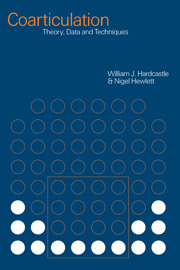Book contents
- Frontmatter
- Contents
- List of figures
- List of tables
- List of contributors
- Acknowledgments
- Introduction
- Part I Theories and models
- Part II Research results: components of the motor system for speech
- 3 Velopharyngeal coarticulation
- 4 Lingual coarticulation
- 5 Laryngeal coarticulation
- 6 Labial coarticulation
- 7 Lip and jaw coarticulation
- Part III Wider perspectives
- Part IV Instrumental techniques
- References
- Index
3 - Velopharyngeal coarticulation
Published online by Cambridge University Press: 22 September 2009
- Frontmatter
- Contents
- List of figures
- List of tables
- List of contributors
- Acknowledgments
- Introduction
- Part I Theories and models
- Part II Research results: components of the motor system for speech
- 3 Velopharyngeal coarticulation
- 4 Lingual coarticulation
- 5 Laryngeal coarticulation
- 6 Labial coarticulation
- 7 Lip and jaw coarticulation
- Part III Wider perspectives
- Part IV Instrumental techniques
- References
- Index
Summary
Introduction
Among the motor sub-systems for speech, the nasal sub-system plays an important part in speech communication, as the degree of oral–nasal coupling is partly responsible for the auditory quality of the human voice. Consequently, the knowledge of its coarticulatory effects in relation to the overall oral system has important implications in both theoretical and clinical research where the assessment of nasality is a crucial problem. There is much to be learned from studies dealing with defective coarticulatory patterns which result in excessive nasalization, distortion or substitution of sounds. Moreover, most speech production models that have been proposed so far are incomplete in that they often fail to take into account the interactions of the respiratory, phonatory and vocal tract components of the speech-producing mechanism. An examination of the coarticulatory relationship between the various sub-systems should allow assessment of the relevance of recently proposed theories on coarticulation and provide useful information for the development of a more complete speech production model.
In this chapter, the main physiological, acoustic and perceptual findings concerning the coarticulatory effects of nasality will be reviewed, with particular attention to its directional effects and its extent. Lastly, some suggestions for future research will be made in domains which, in our opinion, have not been sufficiently explored.
- Type
- Chapter
- Information
- CoarticulationTheory, Data and Techniques, pp. 69 - 79Publisher: Cambridge University PressPrint publication year: 1999
- 5
- Cited by



